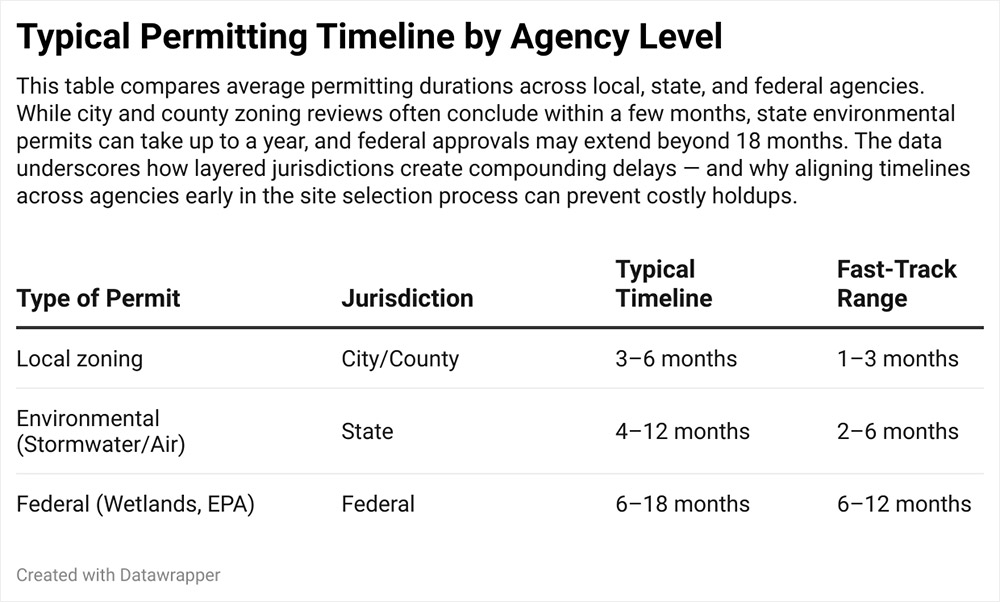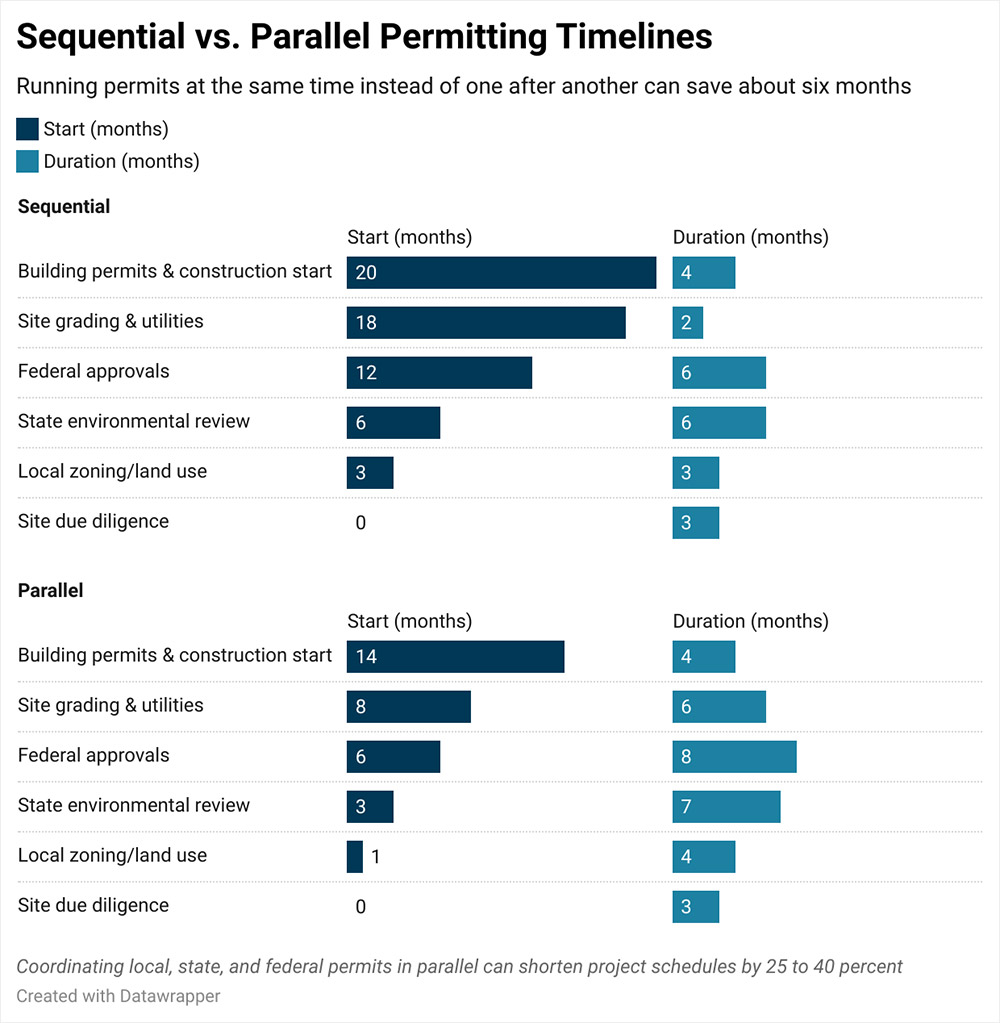In our current economic landscape marked by tariff volatility, global supply chain disruptions, and regulatory uncertainty, the challenges for new greenfield development projects are more complex than ever. For many projects, speed to market is a critical factor, and permitting can be an unforeseen obstacle. Lack of planning or understanding of permitting timelines can impact product deliveries and have significant cost implications.
To even experienced developers and project managers, permitting can begin to feel broken due to a number of key factors. First, in markets experiencing significant growth — whether from residential or commercial development, or a mix of both — backlogs in review and approval times can result from staffing shortages and the limited ability to process permitting using third-party resources. Further, permitting is an inherently local process, with most cities, counties, states, and state agencies having unique methods and standards that applicants must navigate.
Finally, for many permitting processes, there is the potential for political or community opposition during the public input process, whether for a local rezoning or a federal air permit. We’ve seen an increase in public opposition to projects of all sizes in recent years, from distribution centers to OEM mega-projects like Rivian. With local opposition, normally routine permits can eventually result in delays and even messy litigation.
When evaluating permitting considerations for any type of greenfield development, there are a number of factors that project teams should understand and address in their site location and construction plans.
Fast-track permitting isn’t always fast — know what’s actually included before you count on it.
First, in nearly every project, multiple permitting agencies and jurisdictions are required. For instance, at one site, road improvements may be permitted through a city or county, while at another, the same scope of improvements will be permitted by a state department of transportation. These varying jurisdictions may also require different application materials and studies to be submitted, which can also cause delays. For example, in some states, traffic count studies for road improvements can only be completed when school is in session. During site evaluations, it is critical to determine the jurisdiction and application requirements early so adequate time is planned for preparation.
Many permitting processes are handled sequentially, so a delay in one item can cause a cascading effect in the application and approval of other, even unrelated, items.
The permitting process can also uncover hidden risks that may not have surfaced during due diligence. For example, if a stormwater permit review takes longer than expected, it can delay site plan approval, which in turn holds up building permits even though they involve separate departments.

During competitive site selection projects, “fast-track permitting” is often offered as a key incentive and can be attractive for fast-moving deals. However, it’s important to understand the true meaning and limitations of “fast track” depending on the jurisdiction before assessing its value. Does “fast track” include both local and state approvals? If not, which agencies are involved and which are not? Are there any federal permitting items, such as jurisdictional wetland permitting or Title V air permitting, that will be required by the project? Is “fast track” tied to a specific accelerated review timeline, or does it simply mean that permit applications are moved to the “top of the stack” of open applications? Companies should ask for specific approval timelines for each permit required and case studies of successful “fast-track” schedules for similar projects.
12
How can executives with time-sensitive projects ensure the permitting process doesn’t become a drag on the project or an unexpected deal killer? Choosing the right support team is essential to ensuring the success of the project in meeting its goals. Using a site selection firm with an integrated development team can address critical location and development factors in parallel, reducing project risk and saving time and cost on the final build.
An experienced site selection firm can include state and local permitting timelines as a key search criterion during the early project stages. During the site selection process, companies have the most leverage to negotiate meaningful permitting support, and experienced consultants can help create a permitting plan by working through the scope of the broader economic development process.
Such ongoing support can include coordination of permitting jurisdictions for pre-project evaluations, tracking of permitting milestones to real estate and incentives milestones, and negotiation of meaningful “fast-track” benefits for the project.

Most importantly, by addressing permitting during the site selection process, consultants can help to engage communities and public officials proactively to anticipate and resolve potential permitting issues before they cause delays. For instance, when evaluating a site for a new distribution center, an experienced developer will work with consultants to meet early with county planners and nearby property owners to discuss traffic and drainage concerns. By doing so before submitting formal applications, the team can incorporate feedback into the design — avoiding opposition and months of delay during the public hearing phase. Similarly, on the technical side, an experienced development team brings a different perspective to the site selection process and is prepared to build out a realistic work plan and schedule for both permitting and development to meet company needs. An experienced development team brings established relationships with permitting agencies, engineering and architectural firms, and construction partners so that all parties are coordinated for the project’s success.
The right site partner can make permitting a competitive advantage, not a roadblock.
Experienced developers can also help to structure phased permitting and development timelines so that due diligence, permitting review, and site work can proceed in a seamless and straightforward process. For example, the developer might secure early grading and utility permits while the full building permit is still under review, allowing site work to begin without delay. This phased approach keeps construction moving forward and aligns key milestones so that infrastructure, vertical construction, and tenant improvements flow smoothly together.
Finally, experienced developers can ensure that any permitting and entitlement risks are fully understood early, and deal terms can be negotiated to protect the company. For instance, the developer discovering that a site requires a conditional use permit for truck parking might negotiate conditional closing until approvals are secured. This approach limits financial exposure while ensuring that entitlement risks are addressed before the company is fully committed to the deal.In summary, permitting remains a complex and project-specific issue for companies to take seriously when planning for a new greenfield project. With the right site selection and development partner in place, companies can have a coordinated partner helping them to not only select the best location for the project but also anticipate risks and build realistic timelines to keep critical projects on track for success.



